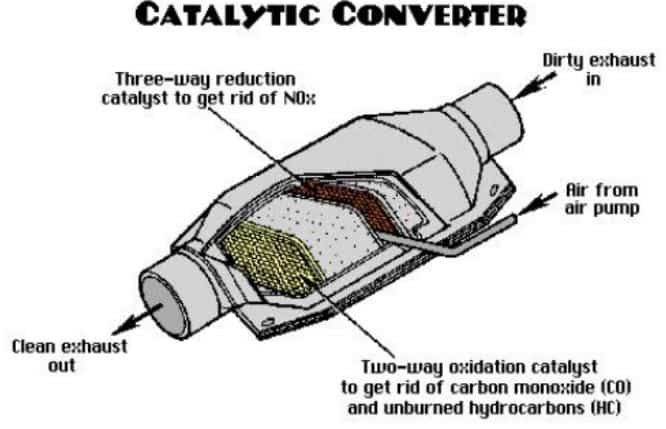A catalytic converter is a safety device that converts harmful emissions from the engine into less hazardous substances and gases. The conversion takes place before these substances are released into the atmosphere. It does this through an oxidation process that takes place in its honeycomb-shaped ceramic substrate. The substrate is coated with platinum, palladium, or rhodium metal to create a catalyst for the chemical reaction. After answering the question, “What is catalytic converter,” Let’s look at some aspects of the catalytic converter as follows:
- Components of the catlytic converter
- Catalytic converter function
- Catalytic converter theft
- Importance of catalytic converter
Components of the catlytic converter
The three main components of the catalytic converter are:
- The ceramic honeycomb catalyst. This contains a mixture of precious metals which are the main cause of catalytic converter theft.
- The exhaust gas recirculation system. This system helps to lower the temperature inside the converter by increasing the amount of oxygen in the air/exhaust mixture.
- A metal tube called an “air duct”. This is where incoming fresh air mixes with exiting gases.
- The catalytic converter also contains sensors that monitor its performance. Moreover, the sensors help the vehicle’s computer to keep running at peak efficiency.
RELATED: How to Use Catalytic Converter Cleaner
The catalytic converter contains a series of brazed honeycomb cells with walls made from thin sheets of stainless steel. The cell size and wall thickness are chosen to optimize space for platinum or palladium on the inside of the cell walls. The cells are then filled with either cordierite ceramic or phenolic resin coated on a substrate material (e.g., Kovar). These are then packed tightly together to form a honeycomb pattern. It is important to realize that with time, the catalytic converter becomes clogged and dirty. Therefore, it is recommended to clean it using a catalytic converter cleaner once a month.
Catalytic converter function
A catalytic converter plays an important role in reducing pollution. In the vehicle exhaust, there are three main types of toxic pollutants: oxides of nitrogen (NOx) and hydrocarbons or volatile organic compounds (VOCs). The catalytic converter reduces these harmful gases to either harmless water vapor and oxygen or non-toxic carbon dioxide.
It is important to note that catalytic converters typically function best when they are not too hot (above 650 degrees Fahrenheit). If the engine operates at or above this temperature, the converter may need repair and replacement.
Catalytic converter theft
Catalytic converter theft is a major problem in the United States. It is estimated that there are 40,000 to 80,000 cars stolen each year and catalytic converter theft accounts for about 50% of these thefts.
A car without a catalytic converter will produce more emissions than one with an intact catalytic converter.
To combat catalytic converter theft, the Department of Transportation banned them for new cars in 1975. It was required that they be removed from existing cars by 1982. Today all states require a replacement catalyst to be installed if one is stolen or damaged beyond repair.
Importance of catalytic converter
- Catalytic converters form an integral part of emissions systems. Therefore, a car without one will produce more pollution.
- Catalytic Converters are essential at reducing harmful emissions that vehicles produce. As a result, they have been a requirement for all cars sold in the United States since 1975.
- Moreover, these devices help to reduce air pollutants. They convert harmful exhaust gases into less toxic substances like carbon dioxide and water vapor.
Therefore, the importance of catalytic converters cannot be understated. However, they can also have negative side effects on the environment when functioning improperly. As a result, it is important to have them repaired or replaced as needed.
Location of the Catalytic Converter
Catalytic converters are typically located near the engine. The location was preferred to maximize exposure to hot exhaust gases. However, some vehicles have them placed after or before the muffler. The latter location can show a lower level of nitric oxide emissions. Additionally, the location also demonstrates an increased level of nitrogen dioxide.
Older catalytic converters will need regular replacement because they lose efficiency over time. On the contrary, newer models can last much longer before needing service or replacement of parts.
The most common cause of a catalytic converter’s failure is theft. The evidence for this is that over 25% of the converters in Texas were found missing.
Summary
Catalytic converters are major components of emissions control systems. Therefore, our air quality would be worse if vehicles are allowed to operate without catalytic converters, . Theft of catalytic converters is rampant in the United States because replacement catalysts cost on average $2000 each. It can take weeks for replacements to be fully effected in the United States. This, therefore means that if your car’s catalytic converter is stolen, you will remain without a car for months.
SEO Writing
If you need help with your content process, you can either email us directly at info@prolatest.com or visit our contact page. We are an SEO company that offers professional writing services for companies looking to rank higher on Google. We are glad to serve you.







